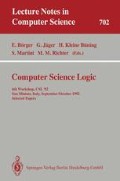Abstract
We develop the first steps of a theory of concurrency within the framework of evolving algebras of Gurevich, with the aim of investigating its suitability for the role of a general framework for modeling concurrent computation. As a basic tool we introduce a ‘modal’ logic of transition rules and runs, which is, in the context of evolving algebras, just a definitional extension of ordinary first order logic. A notion of independence of rules and runs enables us to introduce a notion of (and notation for) concurrent runs, on which a logical theory of (‘true’) concurrency may be based. The notion of concurrent run also has (but does not depend on) an interleaving interpretation. Some basic constructs (concurrent composition, addition of guards and updates) and some derived constructs (internal and external choice, sequential composition) on evolving algebras are introduced and investigated. The power of the framework is demonstrated by developing simple and transparent evolving algebra models for the Chemical Abstract Machine of Berry and Boudol and for the π-calculus of Milner. Their respective notions of parallelism map directly and faithfully to native concurrency of evolving algebras.
Preview
Unable to display preview. Download preview PDF.
References
S.Abramsky, Computational Interpretations of Linear Logic, to appear in Theoretical Computer Science.
P.Aczel, Frege Structures and the Notions of Proposition, Truth and Set, in The Kleene Symposium, North-Holland 1980, pp. 31–59
M.J.Beeson, Foundations of Constructive Mathematics, Springer 1985.
G. Berry, G. Boudol, The Chemical Abstract Machine, Theoretical Computer Science 96 (1992), pp. 217–248 (an earlier version also in POPL'90).
G.Boudol, Communication is an Abstraction, INRIA Rapport de Recherche 636 (1987).
E.Börger, E.Riccobene, A Mathematical Model of Concurrent Prolog, CSTR-92-15, Dept. of Computer Science, University of Bristol, 1992.
E.Börger, E.Riccobene, A formal specification of Parlog. In: M.Droste, Y.Gurevich (Eds.): Semantics of programming languages and model theory, 1993 (to appear).
E.Börger, D.Rosenzweig, The WAM-Definition and Compiler Correctness, TR-14/92, Dipartimento di Informatica, Università di Pisa, June 1992.
E.Börger, D.Rosenzweig, A Simple Mathematical Model for Full Prolog, TR-33/92, Dipartimento di Informatica, Università di Pisa, October 1992.
Y. Gurevich, Logic and the challenge of computer science. in: E. Börger (Ed.), Trends in Theoretical Computer Science, Computer Science Press, Rockville MA 1988, pp. 1–57.
Y. Gurevich, Evolving Algebras. A Tutorial Introduction. in: Bulletin of the European Association for Theoretical Computer Science, no.43, February 1991, pp. 264–284
Y.Gurevich, J.Huggins, The Semantics of the C Programming Language, these Proceedings.
Y. Gurevich, J. Morris, Algebraic operational semantics and Modula-2, in CSL'87, 1st Workshop on Computer Science Logic, Springer LNCS 329 (1988), 81–101.
Y. Gurevich, L.S. Moss, Algebraic Operational Semantics and Occam, in CSL'89, Proceedings of 3rd Workshop on Computer Science Logic, Springer LNCS 440 (1990), pp. 176–196.
D.Harel, Dynamic Logic, in D.M.Gabbay, F.Guenthner (Eds.): Hand-book of Philosophical Logic 2, Reidel 1984, pp. 497–604.
R.Milner, Communication and Concurrency, Prentice Hall 1989.
R.Milner, The Polyadixc π-Calculus: A Tutorial, in Proceedings of the International Summer School on Logic and Algebra of Specification, Marktoberdorf 1991 (to appear).
R. Milner, J. Parrow, D. Walker, Modal Logics for Mobile Processes, in Proceedings of CONCUR'91, Springer LNCS 527 (1991), pp. 45–60.
R. Milner, J. Parrow, D. Walker, A Calculus of Mobile Processes 1,2, Information and Computation 100, 1(1992), pp. 1–77.
A.S.Troelstra, D. van Dalen, Constructivism in Mathematics, North-Holland 1988.
M. Wirsing, Algebraic Specification, in J. van Leeuwen (Ed.): Hand-book of Theoretical Computer Science B, Elsevier 1990, pp. 675–788.
Author information
Authors and Affiliations
Editor information
Rights and permissions
Copyright information
© 1993 Springer-Verlag Berlin Heidelberg
About this paper
Cite this paper
Glavan, P., Rosenzweig, D. (1993). Communicating evolving algebras. In: Börger, E., Jäger, G., Kleine Büning, H., Martini, S., Richter, M.M. (eds) Computer Science Logic. CSL 1992. Lecture Notes in Computer Science, vol 702. Springer, Berlin, Heidelberg. https://doi.org/10.1007/3-540-56992-8_13
Download citation
DOI: https://doi.org/10.1007/3-540-56992-8_13
Published:
Publisher Name: Springer, Berlin, Heidelberg
Print ISBN: 978-3-540-56992-3
Online ISBN: 978-3-540-47890-4
eBook Packages: Springer Book Archive

